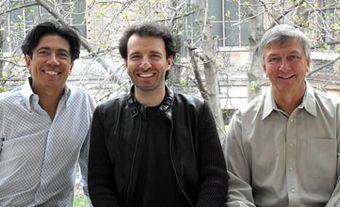Atlantic Symphony Orchestra/Orchestre symphonique de l'Atlantique
Atlantic Symphony Orchestra/Orchestre symphonique de l'Atlantique. Canada's first and only full-time regional orchestra, active 1968-83. The orchestra was formed 12 Jun 1968 with the support of committees in Halifax and Sydney, NS, and Saint John, Moncton, and Fredericton, NB. It was based in Halifax and governed by a board drawn from the above-named committees, each of which was responsible for the orchestra's appearances in its own city. Klaro M. Mizerit was music director and conductor until 1977, when he was succeeded by Victor Yampolsky (b USSR 1942), a violin pupil of David Oistrakh and assistant conductor 1971-3 of the Moscow Philharmonic, who emigrated to the USA in 1973, where he was principal second violin of the Boston SO 1975-7.
When the Halifax Symphony Orchestra and New Brunswick SO were disbanded in 1968, the Atlantic communities agreed to lend joint support to a single paid regional orchestra designed to tour the four Atlantic provinces. The 48-member Atlantic SO was the result. It gave its first concert 14 Oct 1968 at St Patrick's High School, Halifax. During its first season it offered 39 subscription concerts, of which 32 were broadcast by the CBC. By 1977 the orchestra had grown to 65 players, with an operating budget that had increased (from the inaugural year's $380,000) to slightly over $1 million, of which the Canada Council provided about one third, the province and municipalities between 15 and 20 per cent, and private donors and the box office the remainder. During its 10th season the orchestra gave 110 concerts (subscription, school, community, and CBC) in various New Brunswick, Nova Scotia, and Prince Edward Island centres. (Tours in Newfoundland were discontinued when financial support from that province failed.) Ordinarily, after a performance in Halifax at the Rebecca Cohn Auditorium, the orchestra presented the same program on tour in three or four other centres.
Under Mizerit's direction the orchestra played the standard repertoire and some 20th-century works, notably by Stravinsky and Canadian composers. It premiered Jean Coulthard's Endymion and Malamalke (a commissioned work), Wolfgang Bottenberg's Sinfonietta, Edward Laufer's Variations Part II, Adrian Hoffman's Time Did Emit Cool Dense Cities (with the James Davis jazz ensemble), Michael R. Miller's Capriccio on the Seven Ages of Man, and Mizerit's Suite No. 4 for Winds. Under Yampolsky the orchestra continued to play standard and modern repertoire including Turner's Symphony for Strings, Matton's Mouvement symphonique II, Glick's Sinfonia Concertante, Kalnins' Music for String Orchestra and Bottenberg's Fantasia Serena. With the Atlantic Choir (established in 1968 by Mizerit to complement the orchestra in major choral works) the orchestra performed Beethoven's Ninth Symphony, Verdi's Requiem, Orff's Carmina burana, Handel's Messiah, Mozart's Requiem, and Bach's St Matthew Passion and Mass in B-Minor. In its later years the orchestra engaged an increasing number of Canadian soloists, eg, the guitarist Liona Boyd, the soprano Gaelyne Gabora, the cellist Vladimir Orloff, the pianists Robert Silverman, William Tritt and Louis Lortie, and the contralto Maureen Forrester. Guest conductors included Raffi Armenian, Franz-Paul Decker, Kenneth Elloway and Vittorio Negri. Despite its rising musical standards and popularity under Yampolsky, the orchestra suffered from high touring costs, government restraint programs, and declining corporate support. A 1979 labour dispute shut down the orchestra in mid-season for 12 weeks. In September 1982 the Atlantic SO board of directors suspended operations, citing a $407,000 deficit. Fund-raising concerts followed, and in 1983 a 20-week interim season in Halifax, with Boris Brott as artistic adviser and principal conductor, laid the foundation for the formation of Symphony Nova Scotia. The Atlantic SO declared bankruptcy in September 1983, allowing SNS to bid on the former's assets, which included the orchestra library from the Halifax SO in the 1950s.

 Share on Facebook
Share on Facebook Share on X
Share on X Share by Email
Share by Email Share on Google Classroom
Share on Google Classroom

